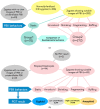Morphokinetic Behavior of the Second Polar Body in Human Zygotes as a Predictor for Embryonic Developmental Potential: An Exploratory Study Based on Time-Lapse Observation
- PMID: 40243997
- PMCID: PMC11989818
- DOI: 10.3390/ijms26073190
Morphokinetic Behavior of the Second Polar Body in Human Zygotes as a Predictor for Embryonic Developmental Potential: An Exploratory Study Based on Time-Lapse Observation
Abstract
Time-lapse imaging has made possible the detailed observation of all stages of embryonic development, including also from the extrusion of the second polar body up to the first cleavage. By extensive observation, we achieved detection of a variety of behaviors of PBIIs such as (a) morphologically static behavior, (b) amoeboid movement, (c) shrinking, (d) fragmenting, and (e) ruffling. Retrospective analysis was performed on 282 ICSI zygotes derived from 69 ART treatment cycles from January to August 2019. Zygotes with morphologically static PBIIs (a) and PBIIs showing various behaviors (b)~(e) were classified into Group 1 (n = 70) and Group 2 (n = 212), respectively. Based on the rates of irregular division, good quality embryos, and the time from the PBII extrusion, pronuclear breakdown to the first cleavage was compared between groups (Study 1). Furthermore, the relationship between the type of PBII behaviors and ploidy in 94 biopsied blastocysts from 15 cycles was examined, in which one or more euploid embryos were obtained between August 2021 and July 2024 (Study 2). The results showed that good quality embryos tended to have morphologically static PBIIs, and that euploid embryos were absent in embryos with fragmenting and ruffling PBIIs. The behavior of PBIIs may be a new predictor of embryonic developmental potential, and, in the future, morphokinetic behaviors of PBIIs may be a useful parameter for AI-assisted embryo evaluation systems.
Keywords: ART; embryo development; morphokinetic behavior; second polar body; time-lapse cinematography.
Conflict of interest statement
The authors have no conflicts of interest to declare.
Figures






Similar articles
-
Focused time-lapse analysis reveals novel aspects of human fertilization and suggests new parameters of embryo viability.Hum Reprod. 2018 Jan 1;33(1):23-31. doi: 10.1093/humrep/dex344. Hum Reprod. 2018. PMID: 29149327
-
Morphokinetics and in vitro developmental potential of monopronucleated ICSI zygotes until the blastocyst stage.Zygote. 2020 Jun;28(3):217-222. doi: 10.1017/S0967199420000027. Epub 2020 Mar 11. Zygote. 2020. PMID: 32156320
-
Correlation between aneuploidy, standard morphology evaluation and morphokinetic development in 1730 biopsied blastocysts: a consecutive case series study.Hum Reprod. 2016 Oct;31(10):2245-54. doi: 10.1093/humrep/dew183. Epub 2016 Sep 2. Hum Reprod. 2016. PMID: 27591227
-
Human 1PN and 3PN zygotes recapitulate all morphokinetic events of normal fertilization but reveal novel developmental errors.Hum Reprod. 2022 Sep 30;37(10):2307-2319. doi: 10.1093/humrep/deac177. Hum Reprod. 2022. PMID: 35950593
-
Morphokinetic features in human embryos: Analysis by our original high-resolution time-lapse cinematography-Summary of the past two decades.Reprod Med Biol. 2024 May 7;23(1):e12578. doi: 10.1002/rmb2.12578. eCollection 2024 Jan-Dec. Reprod Med Biol. 2024. PMID: 38721549 Free PMC article. Review.
References
-
- Biswas D., Sang-Hwan H. Polar Body: Indicator of Oocyte’s Maturation, Have Any Function on Oocyte? J. Embryo Transf. 2009;24:249–251.
-
- Navarro P.A., de Araújo M.M., de Araújo C.M., Rocha M., dos Reis R., Martins W. Relationship between first polar body morphology before intracytoplasmic sperm injection and fertilization rate, cleavage rate, and embryo quality. Int. J. Gynaecol. Obstet. 2009;104:226–229. doi: 10.1016/j.ijgo.2008.11.008. - DOI - PubMed
-
- Kim S., Eum J., Choi W.Y., Paek S., Kwon S., Kim J., Kim R., Hur Y., Yoon T.K., Lee W., et al. Spindle position and second polar body orientation enables the prediction of embryonic developmental potential after ICSI. Fertil. Steril. 2016;106:E325.
MeSH terms
LinkOut - more resources
Full Text Sources

